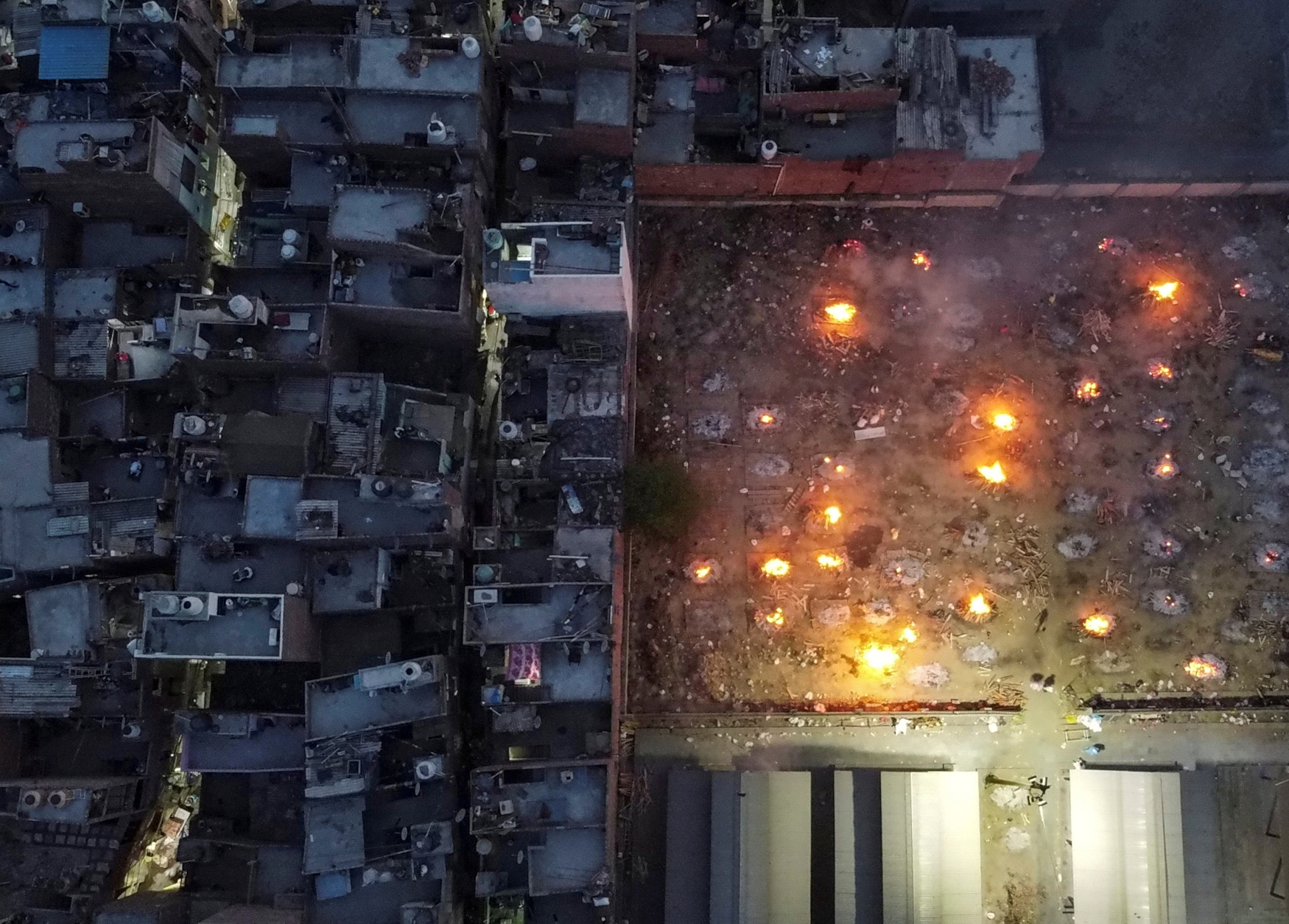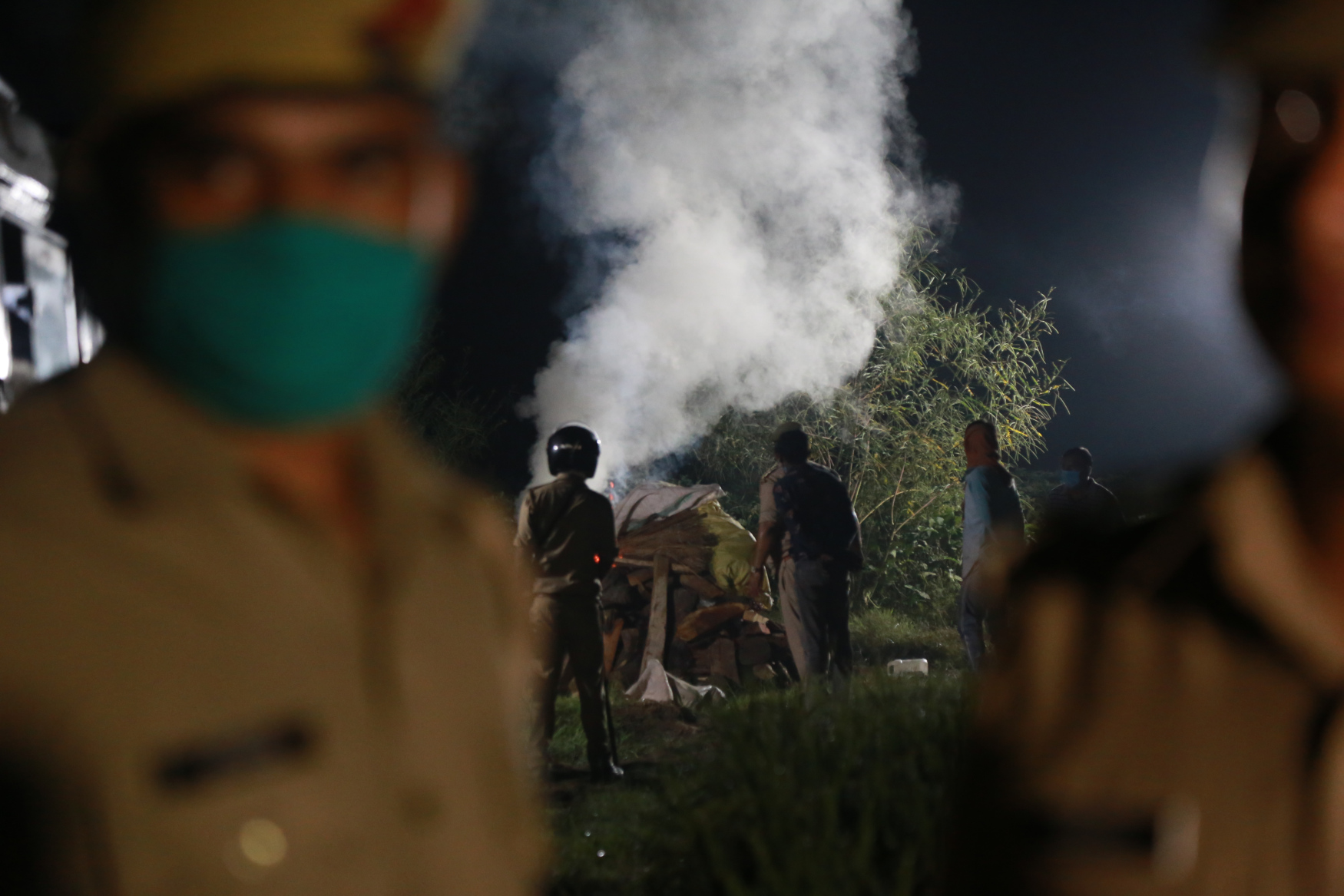
A drone photograph of mass cremations of COVID-19 victims at Delhi’s Old Seemapuri ground by the Reuters photographer Danish Siddiqui. It was one of the first to visualise the massive scale of the crisis (DANISH SIDDIQUI/REUTERS)
A distant, top-angle view shows a tightly packed housing tenement and an empty plot adjacent to it. The plot is scattered with incandescent spots—the brightest of these resembles a bonfire. If you look long enough, in the darker areas you can see fires that are dying out, with the last embers glowing next to blocks of wood and circles of ash. This is a drone photograph of the cremations of COVID-19 victims at Delhi’s Old Seemapuri ground by the Reuters photographer Danish Siddiqui.
As a brutal second wave of COVID-19 swept through the capital in April, this image was one of the first to visualise the massive scale of the crisis. While a still photograph typically displays a particular moment, this image evokes a period of time, a continuous cycle of burning funeral pyres. It had begun to circulate widely across social media on 22 April, amid desperate calls for oxygen, hospital beds and ventilators. It pointed at a reality that everyone had begun to fear: that graveyards and crematoria were overflowing. The composition also expands our view beyond the crematorium. These pyres were burning next to crammed colonies, whose residents had no choice but to breathe the rising smoke from the dead. While the living looked on in horror at the growing death count, what became increasingly clear was the absence of the state in managing the crisis.
For months, the Narendra Modi government turned a deaf ear to panicked warnings from the doctors and health professionals that things had the potential to spin out of control. In January, Modi declared that India had emerged victorious against the coronavirus. In March, newspapers carried advertisements inviting pilgrims to the Kumbh Mela, where millions congregated. Modi stretched out his campaigning for elections in West Bengal, boasting on 17 April about the crowds that had shown up to watch him speak. Three days earlier, the state had recorded its highest spike in new cases thus far. Just days after scores of patients died in hospitals in Maharashtra and Delhi for lack of oxygen, the solicitor general, Tushar Mehta, denied in court that there was an oxygen shortage. The dissonance between such claims and reality was visible in images as well—photographs of overwhelmed hospitals and mounting deaths were circulating widely at the same time as images of pilgrims taking a dip in the Ganga at the Kumbh Mela.
The denialism, lies and underreporting of deaths is now routine. The government has failed to maintain credible data on the COVID-19 crisis since the pandemic began. In September last year, when asked about the number of migrant labourers who had died as a result of a hastily planned lockdown, the government said that “no such data is maintained.” That same month, it repeated this response when it came to the deaths of frontline healthcare workers. This year, the union health minister, Harsh Vardhan, thanked these very “COVID warriors” for leading India to an “unprecedented victory” over the virus. So it was no surprise that the official number of deaths in the second wave also did not align with the reality journalists and photographers were documenting. Ashish K Jha, the dean of the Brown University School of Public Health, was one of many who spoke of the mismatch between official numbers and the facts emerging from crematoria. “You can ignore, fail to test for, or undercount whatever disease you want,” he tweeted. “But you can’t ignore the dead.”
In the face of gross government mismanagement and narrative spin, photographs take on a crucial function. Ordinarily, when there is wide access to credible data, photographs help humanise crises, helping us see the people behind the numbers. In the absence of data, they do not just document the ground reality, but stand as evidence against false claims.
The pandemic has carried with it distinct visual markers: masks, PPE kits and now corpses wrapped in white plastic body bags. With the pandemic having ebbed and peaked at various times across the world, these motifs have attained a certain kind of universality, cropping up in images from Italy to Indonesia. However, the photographs of mass burning pyres broke from this now familiar imagery, disrupting the global narrative. As the West began broadcasting images of vaccination and the opening up of cities, images from Delhi brought worldwide attention to the urgency of the crisis in India.
The international media intervened where the mainstream national media failed. Given that the scale of the tragedy was being continuously suppressed by the authorities, scenes from crematoria and graveyards were proof that something was grossly amiss. The death toll climbed so high that multiple dead bodies, sometimes thirty or forty, had to be burnt at the same time. Publications including the New York Times and Time magazine ran prominent visuals of these scenes. Although similar images of deaths appeared in a few national newspapers and magazines as well, the differences in editorial stance compared to their international counterparts could not have been starker. While Time ran the headline “How Modi Failed Us,” India Today led with an ambiguous cover line—“The Failed State: Who is to blame? What is to be done?” The visual coverage of the deaths, national and international alike, caused something of a social-media storm. Supporters of the Modi government argued that, by using photos like these, journalists were taking “macabre” delight in misery. The right-wing outlet OpIndia called it “feasting on the dead,” and accused Reuters of having a “morbid obsession with watching Hindus burn.”
This charge of voyeurism came hand-in-hand with calls to respect “privacy,” and characterisations of cremations as “sacred and deeply private” events. But the spectacle of burning bodies in India is not new. Funeral pyres on the ghats of Benares have been frequented by tourists for centuries and have been touted as a symbol of India’s Hindu spirituality. In fact, this was not the first time visuals of a cremation caused controversy during the pandemic.

A photograph by photojournalist Manisha Mondal showing Uttar Pradesh police burning the body of a young Dalit woman at Hathras, who was raped and killed by upper-caste men. (MANISHA MONDAL/THE PRINT).
In September 2020, a young Dalit woman was raped and murdered by upper-caste men in the city of Hathras. Her body was hastily burnt in the middle of the night by the Uttar Pradesh police, while her family was kept locked up in their homes and not allowed to perform her last rites. It was another instance of a callous government more interested in burying a story than providing justice. A photograph by Manisha Mondal of The Print showed two policemen on either side of the frame in the foreground while the pyre burnt in the middle of the night, with a plume of smoke rising in the background. Some journalists who tried to report on the incident were arrested, and one was charged with the Unlawful Activities (Prevention) Act while he was on his way to report it. And yet, what could not be hidden is what the photograph evinced: the state standing guard to one of its crimes.
Photojournalists are being pilloried for recording the truth with disconcerting regularity. It was only a year ago that Tushar Mehta, speaking in court, compared journalists and photographers documenting migrants’ plight in the wake of the lockdown to “vultures.” They were blamed for keeping images of migrants’ desperation in circulation—and thus, in public memory. This is the fundamental power that images have. Notable examples that played a vital part in raising public conscience included a haunting video of a young child attempting to wake his dead mother on a railway platform, a video of migrant workers being sprayed with pesticide on the outskirts of Bareilly, and numerous videos and photos of hundreds of people crowding train and bus stations because the government had not provided adequate transport to take them home.
Meanwhile, government authorities have tried various types of cover-ups, some quite literal. In Lucknow, tin walls were put up outside the main crematorium. In Gorakhpur, a banner was put up that read: “Cremation of bodies at the crematorium site is being done as per Hindu customs. Please do not take photographs or make videos. Doing so is a punishable offence.” While the banner was taken down after a social-media uproar, the move betrayed the Uttar Pradesh government’s fear of the photograph and the irrefutable record they created. Similarly, the Central Vista project in Delhi, which has received severe condemnation for its obscenely high expenditure in the middle of a catastrophic health emergency, is marked by similar signs banning photo and video documentation.
In some cases, though, authorities could not act fast enough with censorship. In April, photographs began surfacing of bodies floating in the Ganga, and of shallow graves covered in shrouds along its banks. Later, videos went viral of some men removing these shrouds—possibly to remove visual traces of the burials. The state government denied this was being done on its behalf.
It seems clear that the power of the image is not lost on the establishment. A man such as Modi, who has placed his face on every vaccination certificate, understands the strategic utility of photographs. What he does not consider, though, is that an image is also open to multiple interpretations. His photo on the certificates may well serve as a reminder of how he abdicated his duty.
The fight against images is a battle against memory. It is easier to deny an event, hide injustice and remove it from public memory when no visuals of it exist. But, with the nature of images in today’s world of social media, where the catastrophe is just short of being live-streamed, such suppression is a challenging task. In addition to journalists, ordinary citizens are also armed not just with cameras, but also with distribution systems that have the power to carry images far beyond their immediate surroundings. As has been the case in Uttar Pradesh, despite blatant attempts to prohibit photography of disconcerting events, images of death lodge themselves in our social-media feeds and our psyches.
This is the one crucial difference between the COVID-19 pandemic and historical calamities: the almost instantaneous circulation of images of the former across the world. For example, though millions of lives were lost in the subcontinent during both the 1918 influenza pandemic and the Bengal famine of 1943, channels of communication were largely controlled by the colonial regime at the time and so news of the devastation did not immediately reach many people in other parts of the world. The Statesman, a Calcutta newspaper with a British editor at the helm, famously ran photos of starvation and death during the famine, a largely man-made crisis made worse by a lack of government relief. This was in defiance of the colonial government, which, much like the government today, was attempting to suppress the facts and its role in the calamity. Photographs, even then, served to resist this agenda.
No wonder, then, that supporters of the government have displayed such angst over the international recognition of Siddiqui’s pictures, which were picked up by media outlets after initial circulation on social media. They chided journalists such as him for being “Pulitzer Prize aspirants” and selling India’s death toll to the Western media. Three Kashmiri photographers—Yasin Dar, Channi Anand and Mukhtar Khan—faced similar critiques when they won the Pulitzer last year. Their winning set of images was diverse, ranging from scenes of protest and death to scenes of daily life under heavy militarisation in Kashmir. The Bharatiya Janata Party spokesperson Sambit Patra accused the Pulitzer board of lobbying and of promoting fake news and terror in Kashmir. More than a hundred “Indian dignitaries” wrote an open letter to the board accusing it of misrepresenting facts by calling Kashmir “contested territory.” Amid all the furore, none of them wanted to hear what these images were saying—their appeal to listen to the voices of Kashmiris, their calls for azadi from the tyranny of the Indian state.
While the Pulitzer may well be the Western world’s seal of approval for journalism, awarding this honour to the three Kashmiri photographers, especially in the year following the revocation of Article 370, made a statement: despite what the Indian government may have you believe, just like in the present situation, the world was watching.
Ariella Azoulay, a theorist of visual culture, has written about how photographs — particularly those documenting a reality distant from our own — can serve as catalysts for action. Her focus is the relationship between the spectator and the photograph, expanding beyond theories of the photographer and the subject. She dismisses the idea of “image fatigue” or “compassion fatigue” that theorists including Susan Sontag have written about. Instead, Azoulay takes a scathing view of those who have “simply stopped looking” and, in her eyes, absolve themselves of their responsibility to their fellow humans. If we are given access to view the reality of another, she writes, it is akin to having a “transit visa.” When confronted with these visuals, we are accountable to act on the basis of what we see. Azoulay has disavowed her Israeli citizenship, and much of her writing is in response to images from the occupied Palestinian territories. She offers us the chance to be active participants in the act of viewing the photograph, to not see it as the “pain of others” but as “something that concerns us.”
It has also been argued that foreign publications reporting on the catastrophic situation unfolding in India are facilitating “colonial and racist imagery” by publishing pictures of the dead, and that these media institutions exercise a different ethic when reporting on their own countries. And yet, one of the biggest media stories in the Western world last year was the Black Lives Matter movement, with the protests that followed the death of George Floyd, a gruesome murder that was caught on camera. The video, over nine-minutes long, shows the policeman Derek Chauvin choking Floyd with a knee on his neck, and it was circulated extensively across Western news media. The distribution of these images played its part in fuelling the protests, the scale of which was compared to those during the US Civil Rights Movement of the 1960s.
The Western lens on black and brown bodies has long had its roots in a colonial worldview. The critique that this gaze is carried forward, in various ways, by black and brown image-makers showing their own people is a valid one. However, we must be wary of letting this argument for ethical representation be used for another purpose—the erasure of violent acts from public memory. Images of violent acts and death should only be used when the collective benefit of their circulation greatly outweighs any perceived loss of individual privacy or dignity in death. Where attempts are made to officially suppress stories about death, keeping public memory alive through available recordings is a necessary political act.
Just prior to the BLM protests, New York became one of the main epicentres of COVID-19 in the United States. Drone footage and images by Reuters showed how Hart Island became the city’s mass graveyard. The publication of these images was an anomaly in US visual coverage of the pandemic, which had relied heavily on images of the healthcare system—hospitals, frontline workers—or of the social impact of isolation and masking. Visual reporting from graveyards was rare.
An op-ed published in May 2020 in the New York Times asked the question, “Where are the photos of people dying of COVID?” The writer, Sarah Elizabeth Lewis, argued that, by using tangential visuals to depict the damage done by the virus, the media was detracting from the severity of its impact. According to her, images that show the full extent of the suffering could propel us to better understand the virus, its impact on human bodies and also the extent of precaution it warrants, making it a “matter of public health.” Lewis added that the “visuals we need are hard to come by.” Nonetheless the American press found novel ways to visualise the scale of the tragedy.
On 24 May 2020, the day the United States crossed 100,000 COVID-19 deaths, the New York Times ran a front page full of names culled from obituaries and death notices “to reckon with the milestone.” Along with the name, age and place of residence of each victim, it printed short descriptions of them, such as “known for her Greek chicken and stuffed peppers” or “small in stature but strong in spirit.” The idea behind the project was to recognise that the people who died during the pandemic were not “mere numbers.” To run a front page without an image or a graphic was a first for the paper.
In India, no exercise to show us the true extent of our collective loss has taken place yet—either in the mainstream media or in the collecting of official data. Inspired by the New York Times, the opening image for the cover story in the June 2021 issue of The Caravan is a modest attempt at honouring those who have lost their lives in the second wave, whose deaths may have been entirely avoidable but for the Modi government’s criminal negligence. We can only show a minute fraction of the total death toll, since official estimates have not been reliable. India has in any case had an uneasy relationship with documenting the suffering of the country’s oppressed majority. Poor record-keeping of their deaths is another form of invisibilisation. As long as there are attempts to conceal the truth, we need images to set the record straight.
This article was originally published in the June 2021 issue of The Caravan, New Delhi
